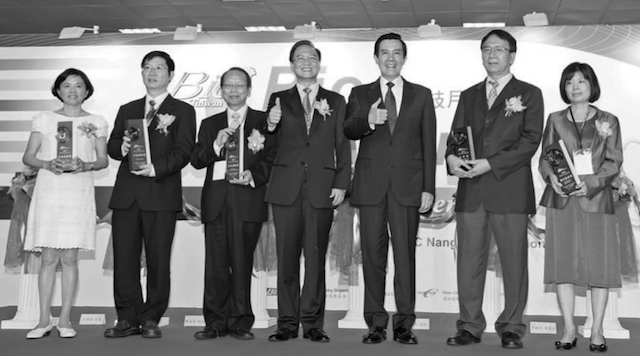The past three years have been some of the most eventful in memory for Taiwan’s life sciences industry. At this year’s Bio Taiwan exhibition, the annual conference that invites the international life sciences com-munity to the island, the excitement was palpable. Foreign companies turned out in record numbers to a keynote address from President Ma Ying-Jeou, who acknowledged that Taiwan was a latecomer to the sector, but nonetheless had the capability and will to compete. Buoyed by a successful wave of financing, good product strategy, and increasing international penetration, the industry seems confident.
Albert Liou, vice chairman of Parexel International, thinks that now Taiwan needs leadership, and success stories. He points to the drug development chain. “Taiwan has great capabilities in each step along the chain,” he says. “But the linkages are not as strong as they could be. Academically and therapeutically, Taiwan is very capable in certain areas, like liver disease. But in terms of drug development from discovery to market, we are several years behind the West. We need leadership that can unite the links in the chain. We need, as well, our first success stories to serve as motivation and as development models.”
Academically and therapeutically, Taiwan is very capable in certain areas, like liver disease. But in terms of drug development from discovery to market, we are several years behind the West. We need leadership that can unite the links in the chain.’ – Albert Liou, vice chairman of Parexel International
“We believe those first stories are coming shortly,” Liou says. As for leadership, many in Taiwan look to a man that has emerged as a major connector in the country’s life sciences industry: Johnsee Lee, who chairs Taiwan’s Development Center for Biotechnology (DCB) and the Taiwan Bio Industry Organization (TBIO).
When Lee took over his post at the DCB in 2010, he felt that the institute focused too much on academic research: “The wrong place for us,” he says. Many industry stakeholders have pointed out that in the life sciences, Taiwan has too long emphasized—“perhaps overemphasized,” says Lee—basic research over commercialization, and that the DCB was doing the same work as other national institutes like Academia Sinica.
Lee quickly got to work positioning DCB as the “second baton in the relay race,” a translational facilitator between the lab and the shelf. As Taiwan implements a strategy that its economic council calls Diversify-Innovate-Globalize (DIG) to ease away from the country’s reliance on information and communication technologies (ICT), commercializing new industries is the name of the game. Biotech is at the top of a list of six strategic emerging sectors: the “key industry” to watch in Taiwan today, says EY’s country managing partner James Wang.
In his capacity as chairman of the TBIO, a unifying association in Taiwan’s life science industry, Lee is responsible not only for helping Taiwan’s drug development effort, but for connecting the dots in a staggeringly diverse sector. In 2013, Taiwan’s Ministry of Economic Affairs (MOEA) counted 1,505 life sciences companies in this market of 23 million people. Grouped under the heading “biotechnology”, these companies may be surprising in number for a small island nation, but they are perhaps most impressive in variety. Taiwan has 450 companies in the applied biotech segment, 350 companies in the pharmaceutical segment and 705 medical devices companies!
Wang believes Taiwan is on to something. “The industry is extremely diverse, and it’s filled with companies that are in most cases much smaller than their Western counterparts,” he says. “But that kind of structure is good— it’s good for innovation, incubation, and cultivating a knowledge focus.”
An IPO case study: Medigen
PharmaBoardroom first met Medigen chairman Stanley Chang in 2010. “Three years ago,” he says, “we sat and spoke in the very same office, with the very same furniture. The difference is that today, our company has grown almost 40 times in value.”
Medigen, whose early-stage liver cancer drug PI-88 should “by all indicators” be the second innovative drug to come out of Taiwan after Tai-gen’s Nemonoxacin, went public on the GreTai exchange in 2011 in an IPO that Chang calls highly successful.
“In the past,” he says, “investors in Taiwan believed that this sector was hopeless, and that drug development was mission impossible. But we have championed the idea that as long as the vision is correct, as long as the strategy is correct, and as long as the market conditions are correct, our goals are achievable!”
Chang believes that investor confidence was bolstered by two factors: trial results, and market potential. PI-88 has now successfully moved to Phase III. Its intended target, liver cancer, is a leading killer in China, Taiwan, and Asia at large.
We are now approaching the international standard. In fact, I believe there is room for further growth.” – Stanley Chang, chairman of Medigen
Medigen is participating in the pilot program that is testing the waters for clinical collaboration between Taiwan and China. Chang is excited: “Investors saw two hurdles for our industry in the past: approval in Taiwan, and approval in China. In the next year or two, those two hurdles will formally become one. There will be mutual recognition—saving huge amounts of time and money.”
Is his company overvalued? Chang says no. “Let’s consider the typical case in the West: normally, when a biotech company has several projects in its portfolio, its frontier product is in Phase III, and its business fundamentals are strong, its share price hovers around USD 10. Hence, our stock price is not over-inflated—rather, companies were undervalued in the past. We are now approaching the international standard. In fact, I believe there is room for further growth.”
To read more articles and interviews from Taiwan, and to download PharmaBoardroom’s latest report on the country, click here.


